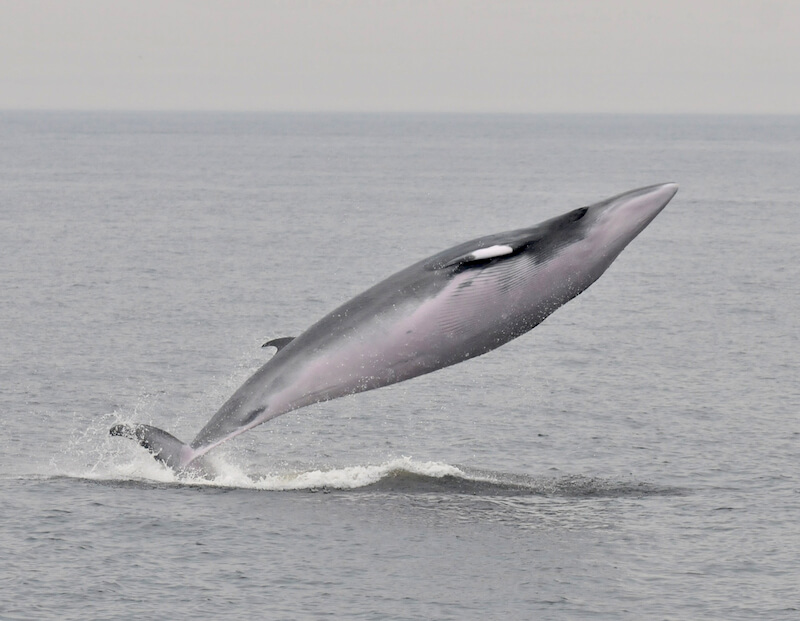“Extraordinary,” exclaims a Franquelin-based collaborator while watching in awe as a minke whale leaps into the air. It repeats the stunt four times. Each time, it lands on its back in a deafening roar. Minke whales are the most acrobatic of the rorquals in terms of repeated breaching and exhibiting their entire bodies, from rostrum to tail. The sound created by their body mass hitting the water is audible for hundreds of metres under the surface. One of the hypotheses regarding breaches performed in feeding areas is that fish might form denser schools owing to the ruckus and might thus be easier to snatch up.
“Captivating,” exclaims Jacques Gélineau of the Nordic Institute for Environmental and Occupational Health Research (INREST) in Sept-Îles upon discovering two fin whales swimming at full throttle (these “greyhounds of the sea” are capable of reaching speeds of 40 km/h), the forepart of their body emerging more than usual from the water and their exhalations being stronger and louder than ever. He made this sighting off Sept-Îles on September 29. This behaviour is not well known in fin whales. It has nevertheless been noted several times in the past by the GREMM team, and, two weeks earlier, a naturalist observed a similar display in two fin whales between Les Escoumins and Tadoussac. The animals even breached at the time, exposing half of their bodies.
These actions are somewhat reminiscent of the blue whale “rumbas” described by the Mingan Island Cetacean Study (MICS). In fall, blue whales pair up more frequently. These couples last for a few days, sometimes even several weeks. According to biopsy monitoring conducted by MICS, they are most often male-female duos. The forming of these pairs could be a precursor to reproduction. Sometimes a second male joins the duo and the three individuals engage in what is called a rumba; the female swims out in front and the two bulls compete to be the closest to her. After a race that can last several hours, one of the males abandons the contest and the other becomes the female’s escort. Do these pairs really result in breeding? A tough question to answer!
“Familiar faces,” observers tell us. This week, blue whales B306 and Chameau are identified in Sept-Îles and Longue-Rive, respectively. Humpbacks Bad Chemistry and Tic Tac Toe, accompanied by their respective newborns, are encountered in the Estuary near Les Escoumins, as is the male Maki (H714). In Gaspé, the humpback H782 is spotted.
“To end my mission with a bang,” writes a member of the Fisheries and Oceans Canada crew aboard the Téléost in the heart of the Gulf of St. Lawrence, “what could be better than white-sided dolphins riding the waves in front of the boat!” These dolphins use the force of the bow wave to propel themselves. Dominant individuals are even believed to position themselves in the most favourable places. They also “glide over” ocean rollers and pester large cetaceans (rorquals and sperm whales) until they speed up, creating a wave on which they can swim.
“Unexpected” is the word that describes one naturalist’s observation from the Pointe-Noire site in Baie-Sainte-Catherine who discovered a narwhal – a mythical species from the Far North – swimming in a herd of adult and young belugas at the mouth of the Saguenay on September 30. According to the witness, the narwhal’s brown “mantle” contrasts with the usual white and gray tones of the belugas. A few days earlier, near Prince Shoal Lighthouse, a naturalist at sea takes a photo that reveals the narwhal, the same animal encountered earlier this summer and last season.
This map represents an order of magnitude rather than a comprehensive survey.
.





